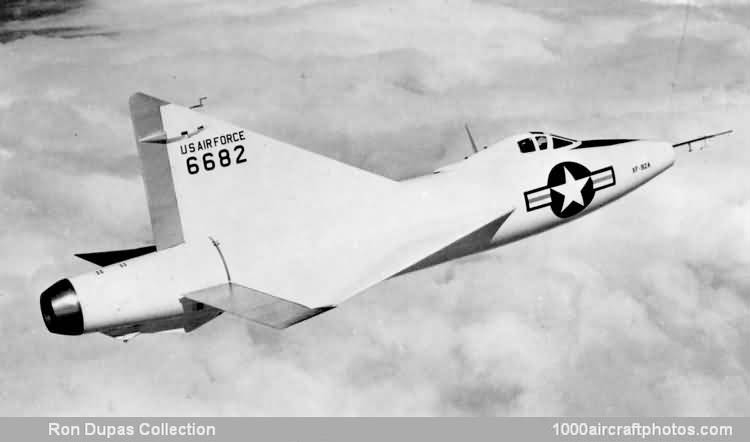08/31/2017. Remarks by Johan Visschedijk: "In August 1945, the USAAF announced a competition for a supersonic interceptor capable of climbing to 50,000 ft (15,240 m) in four minutes and reaching 700 mph (1,127 kmh). The design problem was worked on at Consolidated Vultee (commonly known by its trade name Convair), by Charles R. 'Jack' Irvine (chief engineer), Frank W. Davis (assistant chief engineer), Adolph Burstein (chief development), and Ralph H. Shick (aerodynamics chief), culminating in a radical ramjet design, the XP-92, which won the contest in May 1946.
Two wind-tunnel models had been built at Vultee Field, Downey, California and one of these was subsequently tested to gather preliminary data. The results were immediately disappointing in that the 45° sweptback wing indicated tip stalls at small angles of attack along with lateral control problems. On July 5, 1946, a historic notation appeared in chief designer Burstein's report, 'a 60° delta wing will be investigated this week'.
The delta planform was not new; prewar NACA theoretical studies had indicated high-speed advantages and in wartime Germany, Dr. Alexander Lippisch had built a delta-winged glider, subsequently tested by NACA, which found the data encouraging but the wing thickness too great for supersonic flight. At Downey, fillets placed to fill in the internal angles of the XP-92 wing created a rough delta shape and consultation with Lippisch (then at Wright Patterson) confirmed that the Convair team was on the right track.
In order to speed development of the XP-92, in November 1946 the USAAF approved construction of a 60° delta-winged research aircraft, the Model 7-002. This designation was the accounting department's work order number and quickly became referred to as the 'Seven Balls Two' by the involved personnel. Further savings of time and money were achieved by using the main landing gear from a North American FJ-1, nose wheel assembly from a Bell P-63, engine and hydraulics from a Lockheed P-80, ejector seat and canopy from a cancelled YP-81, and BT-13 rudder pedals. As the delta wing layout cancelled the traditional tail plane, combination aileron/elevator 'elevons' were developed and all flight-controls were hydraulically-actuated and irreversible.
Construction was well advanced when Vultee Field was closed in summer 1947 and the airframe was completed at San Diego that autumn. In December, it was shipped to San Francisco and wind-tunnel tested at NACA's Ames Aeronautical Laboratory at Moffett Field, Sunnyvale, then returned to San Diego for installation of a 4,250 lb (1,928 kg) st Allison J33-A-21 turbojet. The Model 7-002 (serial 46-682) was then taken to Muroc Dry Lake in April 1948 for flight testing by Sam Shannon. Tests were limited to taxiing and high-speed runs until a 5,200 lb (2,359 kg) st J33-A-23 was available although a short 'hop' of a few feet was made on June 9. Meanwhile, realizing the impracticality of the ramjet engine for the XP-92, that program was cancelled by the USAF and the 7-002 was designated XF-92A, allocated purely for delta research.
The first official flight of the 7-002 (and the first flight of a true delta-winged aircraft) was made on September 18, 1948, and Shannon found the controls to be extremely sensitive. Phase 1 testing was shared with Bill Martin from February 9, 1949, and was concluded on August 26 after 47 flights and 20.5 hours. Captain Charles E. 'Chuck' Yeager and Major Frank K. 'Pete' Everest then flew most of the 25 USAF test flights until the end of the year. Although the XF-92A was easy to land and exceptionally stable around Mach 0.9, it lacked the power to go supersonic in level flight and could only exceed Mach 1 in a dive, which it achieved once with Everest as pilot. However, Convair was convinced that it had found a satisfactory supersonic configuration and pressed forward with the F-102.
Refitted with a 7,500 lb (3,402 kg) st J33-A-29 engine with afterburner, the XF-92A was reflown by Yeager on July 20, 1951, but there was little improvement in performance. In contrast to previous experience, maintenance problems surfaced and in 19 months only 21 flights were made. A further engine change was made to the 8,400 lb (3,810 kg) st J33-A-16 and on April 9, 1953, A. Scott Crossfield began flight tests on behalf of NACA. This series of tests revealed violent pitch-up movements in high-speed turns and wing fences were installed to partially solve the problem. On landing after its 25th NACA flight on October 14, 1953, the XF-92A suffered a nose wheel collapse while taxiing at high speed and was withdrawn from service. Disposed of as a static exhibit, the XF-92A was rescued by the USAF in 1969 and is presently on display at its museum at Wright-Patterson AFB, Dayton, Ohio."
